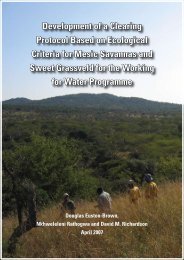Metsi Consultants - DWA Home Page
Metsi Consultants - DWA Home Page
Metsi Consultants - DWA Home Page
You also want an ePaper? Increase the reach of your titles
YUMPU automatically turns print PDFs into web optimized ePapers that Google loves.
Report No 678-F-001<br />
METSI CONSULTANTS: SUMMARY OF MAIN FINDINGS FOR PHASE 1 DEVELOPMENT<br />
12.1. PURPOSE OF THE MONITORING PROGRAMME<br />
SECTION 12. MONITORING PROGRAMME<br />
Monitoring of an ecosystem is a continuing process whereby the condition of key ecosystem components are<br />
measured at repeated intervals following a disturbance and the results compared with the same kinds of data<br />
collected prior to the disturbance. The monitoring described here is specifically related to the IFR determination<br />
described above, and should be distinguished from that required in the application of mitigation and<br />
compensation. The latter would include several components of the former but in addition would need to more<br />
specifically address resource use and the interacting changes over time between reduction in resources used<br />
pre-project and replacement of alternatives post-project.<br />
The disturbances addressed in the IFA would be the ongoing and future construction of in-channel dams on rivers<br />
that would affect the flow regimes, water chemistry, and sediment and temperature regimes and, as a knock-on<br />
effect, their fauna and flora. As discussed in the preceding sections of this report, the disturbances to the rivers<br />
could be reduced by careful manipulation of flow releases from the dams. Monitoring of the flows and their effects<br />
on downstream ecosystems and communities is an essential part of their implementation. Thus once a scenario<br />
has been decided upon and implemented, a monitoring programme should be implemented to:<br />
establish whether or not the agreed-on IFR is being released;<br />
verify if the objectives linked to different components of the flow regime are being achieved;<br />
guide adjustments of either the IFR or the objective, if the overall objective is not being achieved.<br />
The ecosystem components and sub-components that would eventually be included in the monitoring programme<br />
would depend to some extent on the chosen scenario. As a specific scenario or operating regime has yet to be<br />
selected, a generic monitoring programme is described here which includes:<br />
all the disciplines addressed in the study, including biophysical, social, health and economic<br />
components, to the extent deemed necessary by the respective specialists;<br />
activities for assessing the efficacy of the different parts or aspects of the flow regime, where applicable.<br />
12.2. MONITORING SITES<br />
12.2.1 Biophysical Sites<br />
Ideally, the monitoring programme should make use of the same eight biophysical sites as the IFR study, and two<br />
additional sites should be incorporated into the monitoring programme as reference sites. Potential locations for<br />
reference sites would be on the Matsoku River upstream of the headwaters of Matsoku Weir (a reference site for<br />
IFR Site 1) and on the Senqu River downstream of Mokhotlong (a reference site for IFR Sites 2, 3 and 7).<br />
On a more practical basis, however, Phase 1 effects on downstream ecosystems, the natural resource bases and<br />
the use of such resources would be much more evident in the proximal reaches, i.e., reaches immediately below<br />
the LHWP structures (Reaches 1,2,3 and 7 – see Table 10.1 in Section 10) and monitoring should focus primarily<br />
on these areas.<br />
67

















